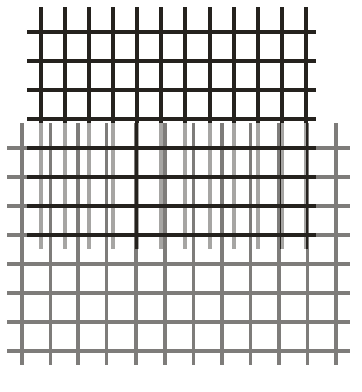All digital SLR cameras contain a piece of glass called the
Anti-Aliasing (AA) or Blur filter to prevent Moiré patterns. If you are
not already familiar, Moiré patterns are repeating light and dark bands that
can occur when photographing a repeating pattern like a screen door or herringbone
shirt with a digital camera. When the pattern spacing approaches the pixel
spacing on the sensor, you can get a Moiré pattern which is a digital artifact
that occurs when sampling resolution (the CCD or CMOS) approaches the signal
frequency (such as the lines of a screen door).
To eliminate or reduce Moiré patterns, the camera
manufacturers
install an AA filter to blur the high frequency information. The AA
filters lets the low frequency information through but blocks the high
frequency. Thus,
although you may own a 10 mega pixel camera, it may only be taking an equivalent
of 7 mega pixels of resolution. Any information approaching the resolution
of the sensor must be blocked to prevent Moiré, but the cost of this is
loss of resolution.
Below is an example illustrating the problem. If the
bottom grid represents the image sensor pixels and the top represents a
repeating pattern with similar spacing, the camera will sometimes see top
pattern correctly and sometimes not. To solve this, the manufactures
blur the image slightly so that any pixel level detail is lost. For
most photographers, they would rather have the sharpest camera possible
because they are more often photographing subjects that don't have these
possible repeating patterns. Problems that do occur can often be
fixed in a program such as Photoshop though sometimes the moiré is a
serious problem that can't be fixed. Our experience has been that
the AA filter solution to reduce moiré on a stock camera usually
sacrifices image quality for all the photographs were moiré is never a
problem - which is most of the time.

We can remove the AA filter and replace with an optical window
with the same refractive index (so that focusing and aperture settings don't
change). This allows the camera to perform at its full resolution with one
possible drawback - Moiré patterns. However, most photographers would
prefer to deal with the occasional Moiré problem by fixing it in Photoshop and
are happy to maximize the resolution of their camera.
We can currently convert many different Canon, Nikon and
Olympus cameras to HR.. The cost is $450 + return S&H ($20 UPS ground insured domestic
USA). We only need camera body, charged battery and cover letter
requesting the conversion type. Turn around is usually 1 or 2 days from
receipt. Conversions are done in our Class 100 clean room with ionized air
and static control surfaces. We have been in business since 1997.
Below are examples for a Canon 5D and a Nikon D200. Both camera bodies
used the same lens, same aperture, same manual white balance and even the same
battery. Both were shot in RAW. The hot rod model is only the left.
Notice that the third picture down shows a Moiré pattern on the air
conditioner grating. All these pictures are small parts of the same RAW file
taken from one shot. These examples are original and un-retouched.
You can download the RAW files here:
Canon
5D Hot Rod (Do a Right Click and Save As)
Canon
5D Stock (Do a Right Click and Save As)
